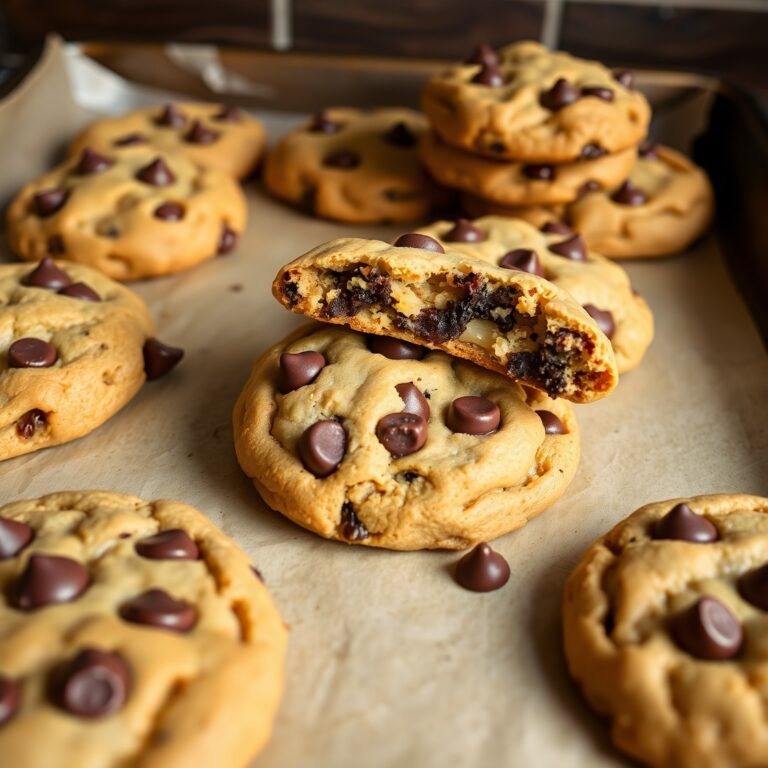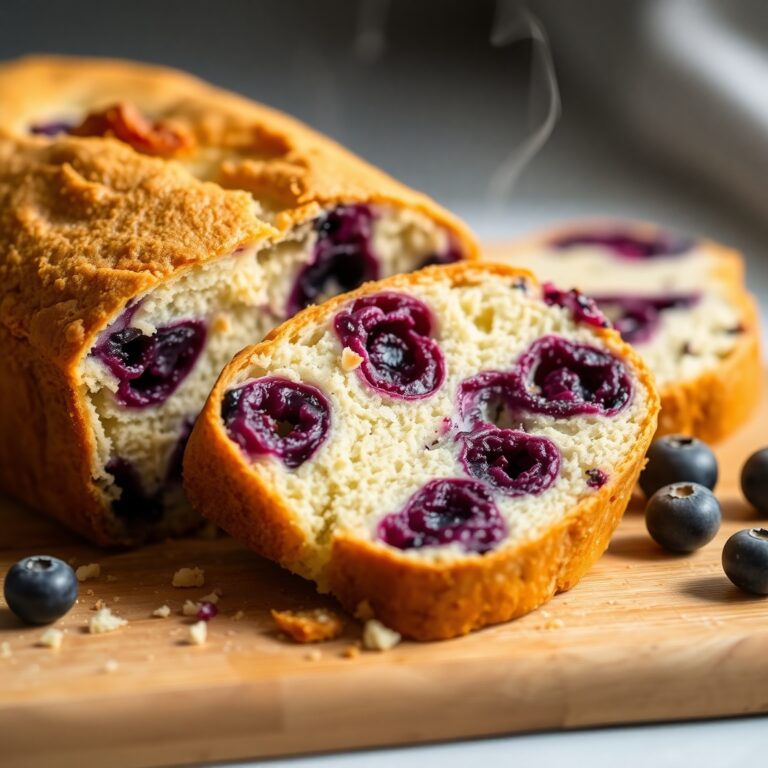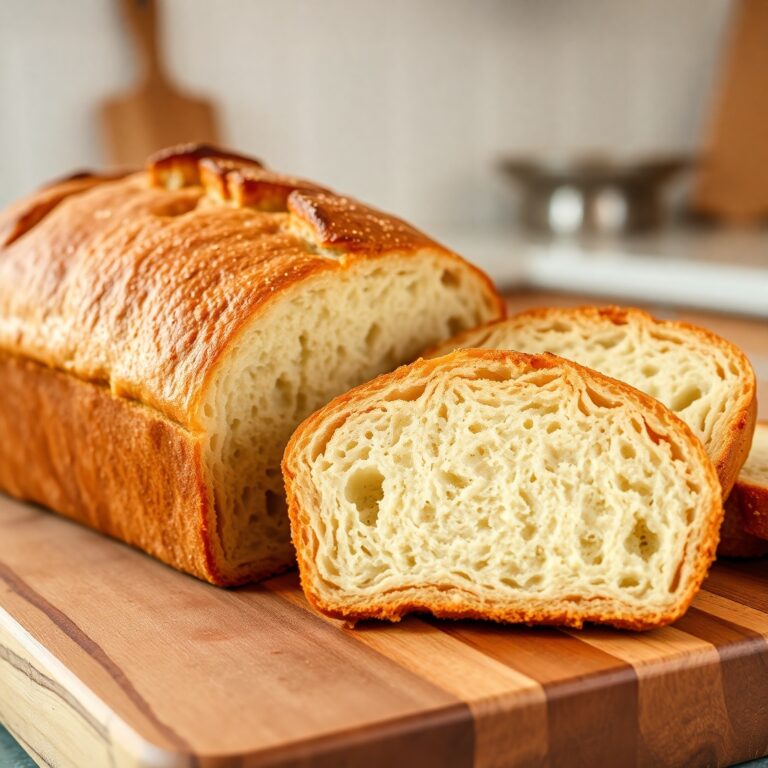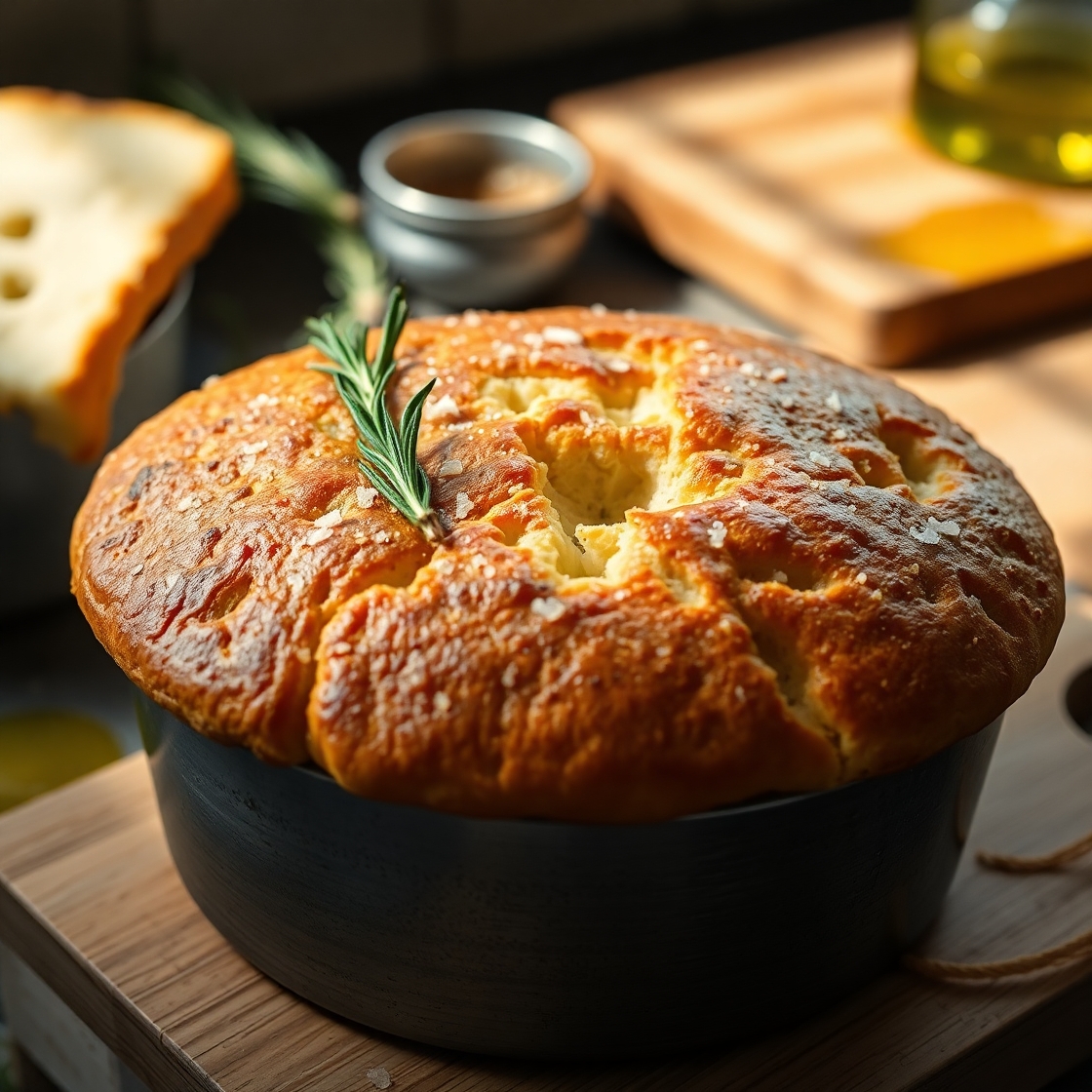
There’s something magical about the scent of fresh focaccia rising in the oven—the warm perfume of olive oil, herbs, and golden crust that fills the air with comfort.
I first made this focaccia recipe during a late summer afternoon when the garden was bursting with rosemary, and we needed something simple yet special to go with a bowl of hearty soup. The result was better than expected: a tender, chewy interior, crisp golden crust, and an olive oil flavor that lingered long after the last bite.
This recipe is for anyone who wants a foolproof way to make bakery-style focaccia right at home. Whether you’re a seasoned bread baker or a beginner ready to try yeast dough, this recipe walks you through each step.
Stick around—because once you learn how easy and satisfying this bread is to make, it just might become your weekly ritual.
Why I Love This Recipe
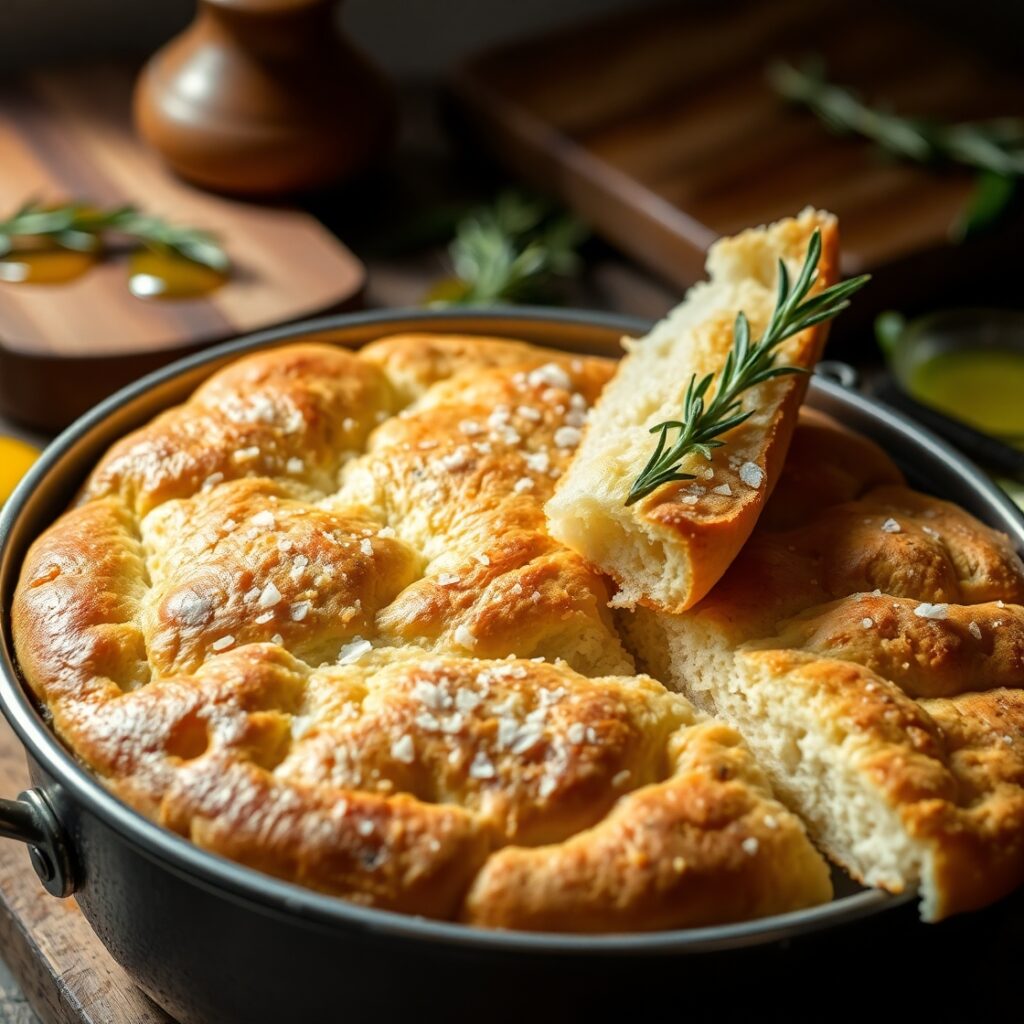
Focaccia bread is one of the most beloved Italian breads for a reason. It’s delightfully chewy, perfectly golden on the outside, and drenched in the richness of good olive oil. What sets it apart from most homemade breads is that it’s incredibly forgiving.
You don’t need a mixer. No shaping. No stress.
It’s made with simple pantry staples—flour, yeast, water, salt, and olive oil—but yields something that tastes like it came out of a rustic Italian bakery. The dough is soft and sticky, which may seem intimidating at first, but that stickiness is what gives focaccia its airy, open crumb.
One of my favorite parts about this recipe is the freedom it allows. You can customize it to suit any meal or season. Add garlic and parmesan, go classic with rosemary and sea salt, or press in olives, tomatoes, and onions for a richer flavor.
Another reason I love making this is the experience itself. The process is therapeutic—from stretching the bubbly dough to dimpling it with your fingers, it’s as satisfying to make as it is to eat.
And let’s not overlook how impressively beautiful it turns out with minimal effort. It’s the kind of bread that turns a simple dinner into something memorable.
Ingredients for Focaccia Bread
Let’s take a closer look at what you’ll need:
Flour – Use all-purpose flour for a tender, light crumb. You can also substitute a portion with bread flour for more structure, but it’s not necessary.
Yeast – Active dry yeast or instant yeast both work. If using active dry, make sure to bloom it in warm water first to activate it.
Warm Water – The water should be about 100°F to 110°F—not too hot, or it can kill the yeast.
Olive Oil – This is the soul of focaccia. Use high-quality extra virgin olive oil for the best flavor. It’s used in the dough, in the pan, and on top.
Salt – Kosher salt goes into the dough and flaky sea salt is sprinkled on top. The salt helps bring out the flavors and gives that classic savory edge.
Sugar or Honey – A small amount helps activate the yeast and enhances browning.
Optional Toppings – Rosemary is the traditional choice, but you can also use sliced cherry tomatoes, caramelized onions, kalamata olives, or thinly sliced garlic.
Every ingredient plays a role. Even though it’s a humble bread, what makes focaccia truly special is the quality and balance of these few ingredients.
How Much Time Will You Need?
Making focaccia does require some planning ahead because of the rising time, but most of it is hands-off.
Here’s a breakdown:
- Preparation Time: 20 minutes
- First Rise (Bulk Fermentation): 2 to 4 hours at room temperature, or overnight in the fridge
- Second Rise (Pan Proofing): 1 to 2 hours
- Baking Time: 25 to 30 minutes
- Cooling Time: 10 minutes before slicing
So in total, plan for about 4 to 6 hours if making it in one day, or you can make the dough a day ahead and bake it the next morning for even better flavor.
How to Make This Focaccia Bread
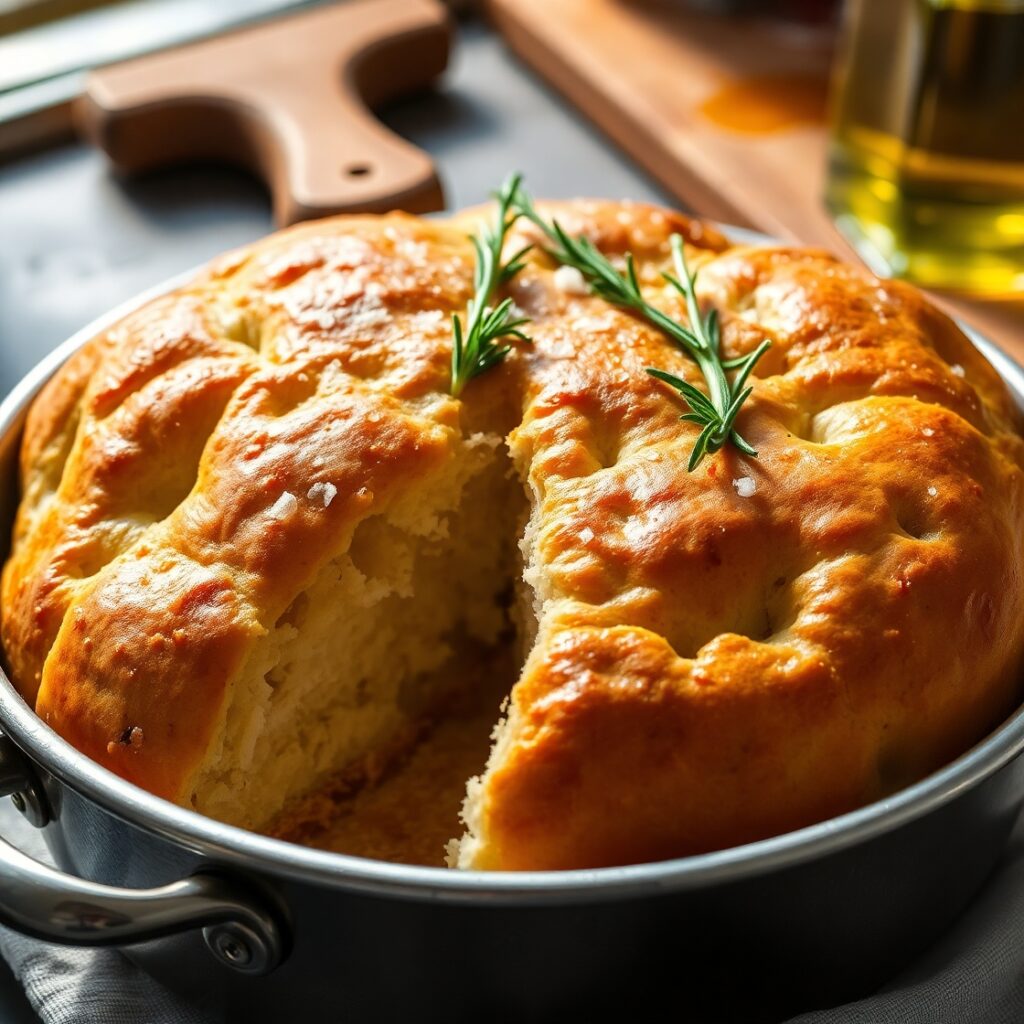
Step – 1: Mix the Dough
In a large bowl, combine 2 ¼ teaspoons of active dry yeast (or one packet) with 1 teaspoon sugar or honey and 1 ¾ cups of warm water. Let sit for 5–10 minutes until foamy.
Once the yeast is activated, stir in 5 tablespoons of olive oil, then add 4 cups of all-purpose flour and 2 teaspoons of kosher salt.
Mix with a wooden spoon or silicone spatula until a shaggy dough forms. The dough will be wet and sticky—that’s perfect.
Step – 2: First Rise
Drizzle a little olive oil over the dough, cover the bowl with a damp towel or plastic wrap, and let it rise in a warm place for 2 to 4 hours, or until doubled and bubbly.
Alternatively, place the covered bowl in the refrigerator overnight for a slower, more developed flavor.
Step – 3: Prepare the Pan
Generously grease a 9×13-inch baking pan (or a sheet pan) with 3 tablespoons of olive oil. Make sure the entire surface is coated, including the corners and sides.
This creates that signature crispy, golden crust.
Step – 4: Stretch the Dough
Transfer the risen dough to the oiled pan. With oiled hands, gently stretch the dough to the edges. If it resists, let it rest for 10 minutes and try again.
Cover loosely and let rise again for 1 to 2 hours, until very puffy and full of bubbles.
Step – 5: Dimple and Add Toppings
Preheat your oven to 450°F (230°C).
With oiled fingers, press deep dimples all over the dough—go right to the bottom of the pan without tearing it. This helps trap pockets of olive oil and air.
Drizzle another 2–3 tablespoons of olive oil on top, sprinkle with flaky sea salt, and add your toppings—rosemary sprigs, garlic slices, olives, or tomatoes.
Step – 6: Bake
Bake in the preheated oven for 25 to 30 minutes, until the top is golden brown and crisp and the bottom sounds hollow when tapped.
Remove from the oven and let cool in the pan for 10 minutes.
Use a spatula to loosen the sides and lift the bread onto a cooling rack. Allow to cool for another 10 minutes before slicing.
Step – 7: Serve
Slice into squares or strips and serve warm, at room temperature, or toasted.
It’s perfect on its own or as a side to soups, salads, and more.
Substitutions
One of the great things about focaccia is how customizable it is. Here are some excellent substitutions:
Flour Alternatives – Use up to 50% whole wheat flour for a nuttier flavor. Bread flour can be substituted for more chew, though it may be less tender.
Yeast Swap – If using instant yeast, you can skip the blooming step and mix it directly into the flour.
Sweetener – Honey, maple syrup, or agave can be used instead of sugar.
Oil Variations – While extra virgin olive oil is classic, you can try infused oils (like garlic or chili oil) for added depth.
Toppings – Swap rosemary for thyme, sage, or za’atar. Use sun-dried tomatoes, caramelized onions, or sliced red grapes for unique flavor twists.
Gluten-Free Flour – A good-quality gluten-free 1:1 flour blend may work, though the texture will differ. Be sure to add xanthan gum if your blend doesn’t contain it.
Best Side Dish of Focaccia Bread
Focaccia shines alongside many meals, but here are three standout pairings that turn a good dinner into a great one:
1. Roasted Tomato Basil Soup
The richness of focaccia dipped in a velvety tomato soup is a timeless comfort.
2. Grilled Chicken Caesar Salad
Crispy-edged focaccia makes a delicious counterpoint to crisp romaine and creamy Caesar dressing.
3. Antipasto Platter
Serve it with cured meats, cheeses, olives, marinated artichokes, and roasted peppers for a rustic Italian starter.
Serving and Presentation Tips
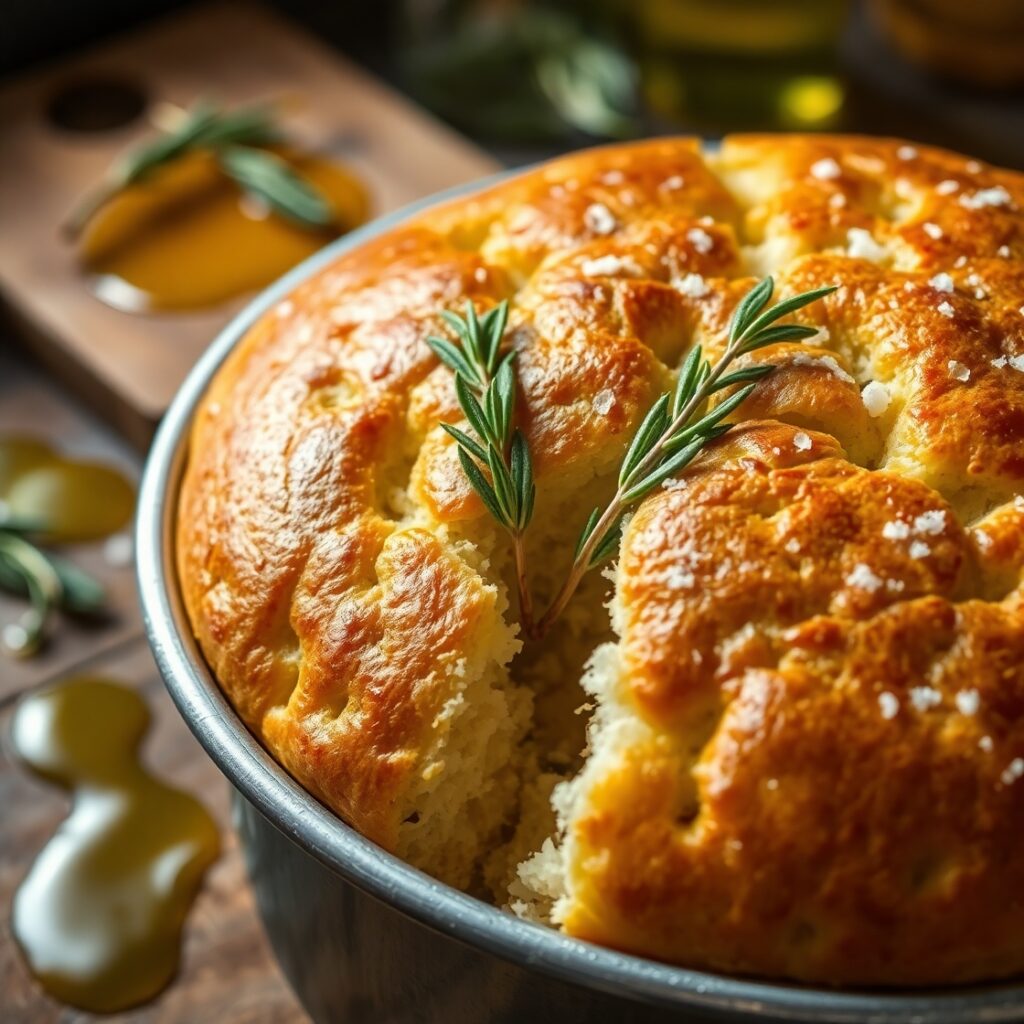
Focaccia bread is inherently rustic, but with a few thoughtful touches, you can elevate its presentation to restaurant-quality.
Start by cutting the focaccia into neat squares or rectangles using a sharp serrated knife. If you’re serving it as a centerpiece, arrange the pieces in a slightly overlapping fan shape on a wooden board.
Drizzle with a touch of olive oil just before serving, and if you’ve used herbs like rosemary or thyme, tuck a fresh sprig onto the board or tray for a touch of greenery and aroma.
For party platters, pair focaccia with a small bowl of good-quality olive oil and balsamic vinegar for dipping. A sprinkle of flaky sea salt or fresh cracked pepper on the board adds visual texture and enhances the experience.
If you’re serving it alongside soup or salad, place the bread on the edge of the bowl or plate for a cozy, casual presentation.
Tips and Tricks to Make This Recipe Even Better
Want bakery-style focaccia every single time? Here’s how to guarantee it:
- Hydration is key – Don’t be tempted to add too much flour. This dough is supposed to be sticky. That high moisture content creates the soft, open crumb and chewy texture.
- Long rise = more flavor – If you have the time, let the dough rise overnight in the fridge. It develops a deeper, more complex flavor that’s worth the wait.
- Generous oiling – Don’t skimp on olive oil. It creates the golden, crispy edges and helps keep the bread moist. Oil the pan, oil the dough, and oil the top.
- Use a metal pan – Glass or ceramic dishes don’t conduct heat as well as a metal pan, which gives you a crispier crust and better color.
- Let it cool – Resist the urge to cut right into it. Allowing it to cool for 10–15 minutes makes it easier to slice and enhances the texture.
- Dimple with confidence – Press your fingers deep into the dough just before baking. The dimples trap oil and help the bread bake evenly.
Common Mistakes to Avoid
Even a straightforward bread like focaccia can go sideways if you’re not careful. Here’s what to watch out for:
- Over-flouring the dough – The dough is supposed to be sticky. Adding too much flour will make the bread dense and tough.
- Under-proofing – If you don’t let the dough rise long enough, your bread won’t have that airy texture. Wait until it’s visibly bubbly and puffy.
- Overproofing – On the flip side, if you let it rise too long during the second proof, it can collapse in the oven. Keep an eye on it once it’s very puffed and dimple immediately before baking.
- Uneven dimpling – Not dimpling deeply or evenly can lead to uneven baking and large bubbles on top.
- Skimping on oil – The olive oil isn’t just for flavor—it’s part of what gives focaccia its iconic crust. Use enough to coat the bottom of the pan and top of the dough.
How to Store It
Focaccia stores well, but like all fresh bread, it’s best enjoyed the day it’s baked.
Short-Term Storage:
Let the bread cool completely, then store it in an airtight container or zip-top bag at room temperature for up to 2 days.
To Reheat:
Warm in a 350°F (175°C) oven for 5–10 minutes to refresh the crust and texture.
Freezing:
Focaccia freezes beautifully. Wrap pieces in plastic wrap and then foil, or place in a freezer-safe bag. Freeze for up to 2 months. Thaw at room temperature and reheat in the oven before serving.
Avoid Refrigeration:
Refrigerating bread can make it stale faster. Stick to room temp or freezer storage.
FAQ
Q1: Can I make focaccia dough ahead of time?
Yes! You can refrigerate the dough for up to 24 hours after the first rise. Let it come to room temperature before shaping and baking.
Q2: Why is my focaccia dense?
This usually means the dough was underproofed or too much flour was added. Make sure your dough rises until bubbly and soft, and resist adding excess flour.
Q3: Can I add cheese to the dough?
Absolutely. You can fold in grated parmesan or cheddar into the dough before the second rise or sprinkle it on top before baking.
Q4: Is focaccia vegan?
This recipe is naturally vegan if you use sugar instead of honey. Just double-check that your toppings don’t include cheese or animal products.
Q5: Can I bake focaccia in a cast iron skillet?
Yes! A well-oiled cast iron pan produces an even crispier crust. Just be sure to adjust baking time slightly since cast iron retains more heat.

Focaccia Bread Recipes
- Total Time: 4–6 hours (including rise time)
- Yield: One 9×13-inch pan (12–16 pieces)
- Diet: Vegetarian
Description
This easy focaccia bread recipe gives you the soft, chewy interior and crispy golden crust of your favorite bakery loaf—right from your own kitchen. With simple ingredients and step-by-step instructions, you’ll master this Italian classic even if you’ve never baked bread before. Dimpled with olive oil, topped with sea salt and herbs, and endlessly customizable, this focaccia is perfect for sandwiches, soups, or as a table bread for entertaining.
Ingredients
- 4 cups all-purpose flour
- 2 ¼ teaspoons active dry yeast (1 packet)
- 1 teaspoon sugar or honey
- 1 ¾ cups warm water (100–110°F)
- 5 tablespoons olive oil (plus more for pan and drizzling)
- 2 teaspoons kosher salt
- Flaky sea salt, for topping
- Fresh rosemary (or other toppings)
Instructions
- Bloom yeast with sugar and warm water for 5–10 minutes until foamy.
- Add olive oil, flour, and kosher salt. Stir until a sticky dough forms.
- Cover and let rise 2–4 hours at room temp or overnight in fridge.
- Grease a 9×13 pan with 3 tablespoons olive oil.
- Transfer dough to pan, stretch gently to edges, let rise again 1–2 hours.
- Dimple dough with oiled fingers, drizzle more olive oil, add toppings.
- Bake at 450°F for 25–30 minutes until golden.
- Cool in pan 10 minutes, then transfer to rack and cool another 10. Slice and serve.
Notes
For deeper flavor, use the cold fermentation method and rise the dough overnight.
Use a metal pan for the crispiest crust.
Don’t skip the dimpling—it helps prevent large air bubbles and improves texture.
- Prep Time: 20 minutes
- Cook Time: 25–30 minutes
- Category: Bread
- Method: Baking
- Cuisine: Italian
Nutrition
- Serving Size: 1 slice
- Calories: 195

